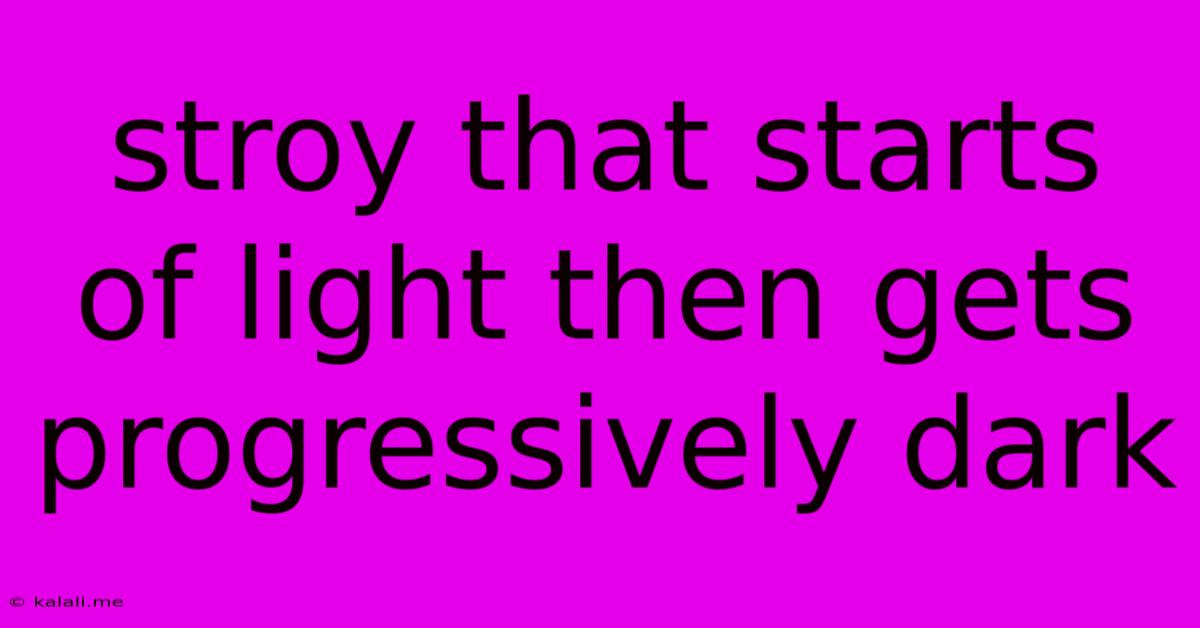Stroy That Starts Of Light Then Gets Progressively Dark
Kalali
Jun 08, 2025 · 3 min read

Table of Contents
From Golden Sunsets to Shadowy Depths: Crafting a Story That Starts Light Then Gets Progressively Dark
The allure of a story that begins with a gentle sunrise and ends in a chilling twilight is undeniable. This narrative arc, a slow descent into darkness, offers a powerful emotional impact, keeping readers hooked while simultaneously exploring complex themes. This article will guide you through the art of crafting such a narrative, exploring the key elements and techniques needed to create a truly compelling and memorable story.
The initial lightness sets the stage, creating a false sense of security, a stark contrast to the looming darkness. This juxtaposition is crucial to the story's effectiveness. Think of it as building a foundation of hope before subtly undermining it, layer by layer.
Building the Foundation: Establishing the Light
The opening of your story should feel warm and inviting. This doesn't necessarily mean a fairytale beginning; it could be the simple joy of a childhood memory, the comforting rhythm of daily life, or the blossoming of a new relationship. Focus on:
- Sensory Details: Engage the reader's senses. Describe the vibrant colors of a sunset, the comforting scent of freshly baked bread, the gentle touch of a loved one's hand. These details establish a sense of peace and normalcy.
- Character Introduction: Introduce your characters in a positive light, showcasing their strengths and aspirations. This makes their eventual downfall all the more impactful. Highlight their flaws subtly; don't make them perfect.
- Setting the Scene: The initial setting should be idyllic and peaceful. A sun-drenched meadow, a bustling but friendly town, a cozy home – these settings create a stark contrast to the later, darker elements.
- Establishing Hope: Inject a sense of hope and optimism. This could be a specific goal the protagonist is pursuing, a blossoming friendship, or simply the feeling of contentment.
The Gradual Descent: Introducing Darkness
The transition from light to dark should be gradual, subtle. Avoid jarring shifts; instead, introduce elements of unease slowly. This can involve:
- Subtle Foreshadowing: Plant seeds of doubt and unease early on. This could be a recurring symbol, a cryptic warning, or a seemingly insignificant event that later takes on greater significance.
- Rising Tension: Gradually increase the tension through escalating conflicts, both internal and external. Small problems become larger obstacles, and minor annoyances turn into significant threats.
- Character Development: Allow your characters to face challenges that test their resilience. Their struggles, and their responses to them, will shape the narrative's darkening tone. Perhaps a trusted friend reveals a hidden agenda, or a loved one falls ill.
- Shifting Setting: As the story progresses, the setting can subtly change to reflect the shifting mood. The once vibrant meadow might become overgrown and shadowy, the bustling town might become eerily quiet, or the cozy home might feel cold and empty.
Embracing the Darkness: Reaching the Climax
The climax should represent the full realization of the darkness. This is where the previously established hope is shattered, and the consequences of the characters' actions (or inaction) are fully revealed. This could be:
- A Betrayal: A trusted friend or loved one might betray the protagonist, leading to devastating consequences.
- A Loss: The protagonist might experience a significant loss – a death, a broken relationship, or the failure of a cherished dream.
- A Moral Dilemma: The protagonist might face a difficult moral choice with no easy answers.
- A Confrontation: The protagonist might confront the source of their problems in a powerful and emotionally charged scene.
The Aftermath: Exploring the Consequences
The ending doesn't have to be utterly bleak. It can be a moment of acceptance, a hard-won victory tinged with sadness, or a quiet reflection on the events that have transpired. The key is to allow the darkness to leave a lasting impact on the characters and the story's overall tone.
By carefully orchestrating the shift from light to dark, you can create a story that is both captivating and emotionally resonant, leaving a lasting impression on your readers long after they’ve finished the final page. Remember, the journey is just as important as the destination.
Latest Posts
Latest Posts
-
Do Oleucles Travel Poerendicular In Transverse Waves
Jun 08, 2025
-
How Many Focus Points Do You Get Pathfinder 2e
Jun 08, 2025
-
Do Rotors Need To Be Replaced With Pads
Jun 08, 2025
-
How To Drill Through Thick Steel
Jun 08, 2025
-
Will A 5x115 Fit A 5x114 3
Jun 08, 2025
Related Post
Thank you for visiting our website which covers about Stroy That Starts Of Light Then Gets Progressively Dark . We hope the information provided has been useful to you. Feel free to contact us if you have any questions or need further assistance. See you next time and don't miss to bookmark.